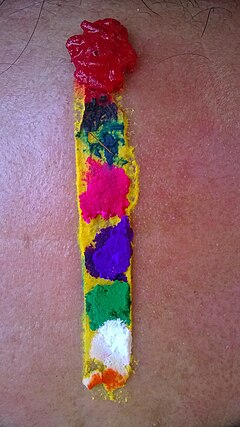Our Lady of Good Health also known as Our Lady of Vailankanni, is the title given to the Blessed Virgin Mary by people as she twice appeared in the town of Velankanni, Tamil Nadu, India, in the 16th to 17th centuries. According to traditions, the first Marian apparition is said to have occurred to a young boy delivering butter-milk to a man who lived far away. During his travels, the boy stopped to rest beside a lake that was shaded by a Banyan tree. A beautiful woman, carrying a child, is said to have appeared, and asked the boy for some milk to feed her child, which he gave. When he reached the home for his milk delivery, he apologised for the delay and that there would be less milk in his pot. But when they opened the lid of the milk pot, the container was brimming with milk.
The second apparition occurred a few years later. A lame boy would sell buttermilk to passing travellers, who would pause in the shade of a large Banyan tree, to escape the heat of the day. However, he had no customers. Suddenly, an ethereal woman, holding a child appeared before him, and asked for a cup of buttermilk. He gave her a cup, which she fed to her child. The woman asked the boy to go to Nagapattinam, and find a certain Catholic man in the town, and tell him to build a chapel at Vailankanni in her honour. Apparently cured, the boy ran to Nagapattinam, where he found the man and told him his story.
The Basilica of Our Lady of Good Health erected by the Portuguese and the Indians stands at the site where the buttermilk sellers saw Mary and Jesus.
The basilica is known as a site for pilgrims from all over India.
September 8, the Feast of the Nativity of Mary, is also commemorated as the feast of Our Lady of Good Health. The celebration starts on 29 August and ends on the day of the feast. The feast day prayers are said in Tamil, Marathi, East Indian, Malayalam, Telugu, Kannada, Konkani, Hindi and English.
This festival gets started with a flag hoisting ceremony at the church. The flag is hoisted every day for 9 continuous days along with the other activities that catch the eyes of the devotees.
People from various parts of the country reach Velankanni Church to be a part of the feast and enjoy the same. There are musical concerts, plays, Bharatnatyam Dance performances and a car procession that are the major highlights of this wonderful event. To experience the charm and take the blessings of ‘Our Lady of Health’, book a flight, bus, train to Velankanni for 25th August.
The second apparition occurred a few years later. A lame boy would sell buttermilk to passing travellers, who would pause in the shade of a large Banyan tree, to escape the heat of the day. However, he had no customers. Suddenly, an ethereal woman, holding a child appeared before him, and asked for a cup of buttermilk. He gave her a cup, which she fed to her child. The woman asked the boy to go to Nagapattinam, and find a certain Catholic man in the town, and tell him to build a chapel at Vailankanni in her honour. Apparently cured, the boy ran to Nagapattinam, where he found the man and told him his story.
The Basilica of Our Lady of Good Health erected by the Portuguese and the Indians stands at the site where the buttermilk sellers saw Mary and Jesus.
The basilica is known as a site for pilgrims from all over India.
September 8, the Feast of the Nativity of Mary, is also commemorated as the feast of Our Lady of Good Health. The celebration starts on 29 August and ends on the day of the feast. The feast day prayers are said in Tamil, Marathi, East Indian, Malayalam, Telugu, Kannada, Konkani, Hindi and English.
This festival gets started with a flag hoisting ceremony at the church. The flag is hoisted every day for 9 continuous days along with the other activities that catch the eyes of the devotees.
People from various parts of the country reach Velankanni Church to be a part of the feast and enjoy the same. There are musical concerts, plays, Bharatnatyam Dance performances and a car procession that are the major highlights of this wonderful event. To experience the charm and take the blessings of ‘Our Lady of Health’, book a flight, bus, train to Velankanni for 25th August.










